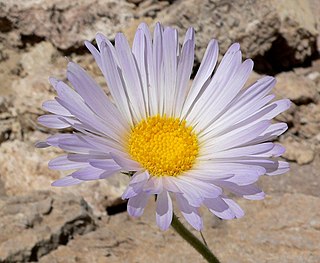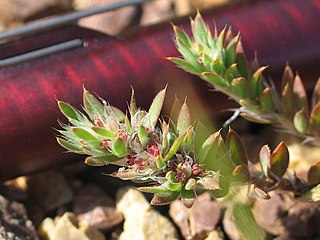
Eryngium is a genus of flowering plants in the family Apiaceae. There are about 250 species. The genus has a cosmopolitan distribution, with the center of diversity in South America. Common names include eryngo and sea holly.

Eryngium yuccifolium, known as rattlesnake master, button eryngo, and button snake-root, is a perennial herb of the parsley family native to the tallgrass prairies of central and eastern North America. It grows from Minnesota east to Ohio and south to Texas and Florida, including a few spots in Connecticut, New Jersey, Maryland, and Delaware.

Phlox hoodii, the spiny phlox or carpet phlox, is a species of phlox. It is a plant of western North America, where it is a common flower in sagebrush country, mostly growing in dry lithosol habitats. It is among the first plants to bloom in spring, after the snow has melted. Its distribution extends from Alaska to Arizona. There are many subspecies.

Eryngium aristulatum, known by the common names California eryngo and Jepson's button celery, is a species of flowering plant in the family Apiaceae.

Eryngium armatum, known by the common names coastal eryngo and prickly coyote thistle, is a species of flowering plant in the family Apiaceae.
Eryngium castrense is a species of flowering plant in the family Apiaceae known by the common name Great Valley eryngo, or Great Valley button celery. This plant is endemic to California, where it grows in wet areas such as vernal pools and ponds in the central part of the state. This is a heavily branched, spiny perennial herb reaching maximum heights of around half a meter. It produces light green to grayish green hairless stems with occasional lobed, oval-shaped leaves. At the tops of the stems are flower heads one to one and a half centimeters wide and rounded or egg-shaped. At the base of each head is an array of 7 to 9 spiny, pointed bracts up to three centimeters long, and sometimes a few smaller bractlets above. The rounded flower head contains many small white to light purple flowers.
Eryngium constancei is a species of flowering plant in the family Apiaceae known by the common name Loch Lomond button celery, or Loch Lomond coyote thistle. It is endemic to California, where it is known from only three occurrences north of the San Francisco Bay Area. One of the populations is at the Loch Lomond Vernal Pool Ecological Reserve at Loch Lomond in Lake County. The plant appears mainly in vernal pools. It is endangered on the state and federal levels.

Calochortus venustus is a California species of flowering plants in the lily family known by the common name butterfly mariposa lily. It is a perennial herb that grows in grasslands and open wooded areas.

Cirsium douglasii is a species of thistle known by the common names Douglas' thistle and California swamp thistle.

Cirsium undulatum is a species of thistle known by the common names wavyleaf thistle and gray thistle. It is native to much of central and western North America from British Columbia east to Manitoba and south as far as the State of Durango in Mexico. It has also been found outside of its native range as an introduced species.
Eryngium mathiasiae is a species of flowering plant in the family Apiaceae known by the common name Mathias' eryngo, or Mathias' button celery.
Eryngium pinnatisectum is an uncommon species of flowering plant in the family Apiaceae, known by the common names Tuolumne eryngo and Tuolumne button celery.
Eryngium racemosum is a rare species of flowering plant in the family Apiaceae known by the common name delta eryngo, or delta button celery.
Eryngium vaseyi is a species of flowering plant in the family Apiaceae known by the common name coyotethistle. It is endemic to California, where it is known from vernal pools and similar wet habitat in the Central Valley and certain areas of the Central Coast Ranges and southern California coast. This is a decumbent to upright perennial herb with spreading branches up to half a meter long. The lance-shaped to oblong leaves may be up to 24 centimeters long. The edges are deeply cut into narrow, sharp-pointed lobes. The inflorescence is an array of somewhat rounded flower heads surrounded by several narrow, pointed bracts with spiny edges. The head blooms in whitish petals.

Lomatium caruifolium, known by the common name alkali desertparsley, is a species of flowering plant in the carrot family.

Xylorhiza tortifolia is a species of flowering plant in the family Asteraceae, known by the common names Mojave-aster and Mojave woodyaster.

Eryngium pendletonense is a rare species of flowering plant in the carrot family known by the common name Pendleton button-celery. It is endemic to northern San Diego County, California, where it is known from four occurrences along the coastline between Oceanside and the Orange County border, including land within Camp Pendleton. It grows on vernally moist coastal grassland and coastal sage scrub habitat with clay soils. It was first described as a species in 1999.
Navarretia ojaiensis is a rare species of flowering plant in the phlox family known by the common name Ojai navarretia.

Eryngium aquaticum is a species of flowering plant in the family Apiaceae known by the common name rattlesnakemaster, marsh rattlesnake master, corn-snakeroot, bitter snakeroot, and marsh eryngo. This plant is native to eastern North America.

Paronychia franciscana is a species of flowering plant in the family Caryophyllaceae known by the common names San Francisco nailwort, California Whitlow-wort, Franciscan paronychia, and Chilean nailwort. It is native to Chile, but it was first described from specimens collected in San Francisco, California, in the United States, where it is an introduced species.













